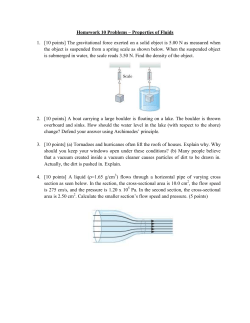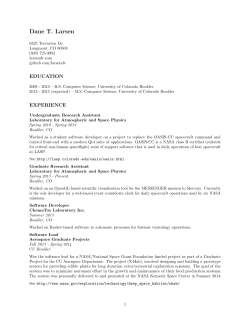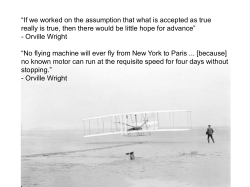
Homework 10 Solutions
Homework 10 Solutions 1. [10 points] The gravitational force exerted on a solid object is 5.00 N as measured when the object is suspended from a spring scale as shown below. When the suspended object is submerged in water, the scale reads 3.50 N. Find the density of the object. Answer: Because the suspended object weighs 5.00 N outside of the fluid and 3.50 N when submerged in the fluid, this implies that buoyancy force acting on the object is 1.50 N. By Archimedes’ principle, the weight of the displaced fluid is the same magnitude as the buoyancy force. Therefore, the volume of the fluid displaced is given by ( )( ) When the object is fully submerged in water, the volume of water displaced by the object will be the same as the volume of the submerged object. Therefore, the density of the object is given by ( )( ) 2. [10 points] A boat carrying a large boulder is floating on a lake. The boulder is thrown overboard and sinks. How should the water level in the lake (with respect to the shore) change? Defend your answer using Archimedes’ principle. Answer: When the large boulder and boat are floating on the lake, this implies that the buoyancy force associated with water is balanced with the combined weight of the large boulder and the boat. By Archimedes’ principle, this implies that the boat and boulder are displacing enough water to balance the combined weight of both objects. When the boulder is removed from the boat, the boat weighs less and thus displaces less water in order to float, causing the water level to drop and the boat to rise higher. When the rock is thrown into the water, it will sink down to the bottom, implying that the density of the rock is greater than the density of the water. This implies that the buoyancy force acting on the boulder is weaker than the weight of the object and, by Archimedes’ principle, implies that the boulder cannot displace enough water in order to support its weight. Therefore, the overall effect is that the water level in the lake drops with respect to the shore. When the boulder is in the boat, it’s able to displace enough water to support its weight (due to the combined volume of the boulder and the boat), whereas when the boulder is thrown overboard, it’s unable to displace enough water to support its weight. 3. [10 points] (a) Tornadoes and hurricanes often lift the roofs of houses. Explain why. Why should you keep your windows open under these conditions? (b) Many people believe that a vacuum created inside a vacuum cleaner causes particles of dirt to be drawn in. Actually, the dirt is pushed in. Explain. Answer: Both of these processes can be described using Bernoulli’s principle. For relatively small changes in gravitational potential energy, Bernoulli’s principle states swiftly moving fluids exert less pressure than do slowly moving fluids. When a tornado or hurricane blows across the roof of a house, Bernoulli’s principle states that the pressure on top of the roof will decrease, relative to the air pressure within the house. This implies that there will be a net upward force on the roof, causing the roof to lift. Opening the window removes this change in pressure and thus removes the net upward force on the roof. Similarly, when a vacuum cleaner blows over a region of dirt, Bernoulli’s principle states that the pressure within the vacuum decreases. This implies that there will be a net upward force which draws the dirt in the vacuum. 4. [10 points] A liquid (ρ=1.65 g/cm3) flows through a horizontal pipe of varying cross section as seen below. In the section, the cross-sectional area is 10.0 cm2, the flow speed is 275 cm/s, and the pressure is 1.20 x 105 Pa. In the second section, the cross-sectional area is 2.50 cm2. Calculate the smaller section’s flow speed and pressure. (5 points) Answer: To determine the flow speed through the smaller section, we can use the continuity equation. ( ) ( )( ) To determine the pressure in the smaller section, we use Bernoulli’s equation (neglecting changes in gravitational potential energy) ( ) ( ) ( ) [( ) ( ) ] 5. [10 points] Water moves through a constricted pipe in steady, ideal flow. At the lower point shown below, the pressure is 1.75 x 105 Pa and the pipe radius is 3.00 cm. At the higher point located at y = 2.50 m, the pressure is 1.20 x 105 Pa and the pipe radius is 1.50 cm. a. Find the speed of the flow in the lower section b. Find the speed of the flow in the upper section c. Find the volume flow rate through the pipe Answer: Through the continuity equation we can relate the speed of the flow in the upper section to the speed of the flow in the lower section ( ) ( ) Since the radius in the lower section is double the radius of the upper section, this implies that the cross-sectional area of the lower section is four times as much as the cross-sectional radius of the upper section. Therefore, Equation (1) becomes ( ) To determine the speed in the lower section , we can use Bernoulli’s equation ( ) Substituting (2) into (3) gives [ Solving for gives ] √ ( ) [ √ ( ) ] ( ) )[ ( )( ( )( ] Therefore, the speed of the flow in the upper section of the pipe is given by Equation (2) ( ) The volume flow rate is given by ( ) ( ) ) Bonus: [5 points] A jet of water squirts out horizontally from a hole near the bottom of the tank, shown below. If the hole has a diameter of 3.50 mm, what is the height h of the water level in the tank? Answer: We first need to determine the speed of the fluid as it leaves the tank. We note that after the fluid leaves the tank, it undergoes projectile motion. To determine the fluid speed, we use kinematics equation 2 in both the horizontal and vertical direction (note that ) ( ) √ √ )( ( ( ) ) To determine the height of the water tank, we use Bernoulli’s equation (ignoring changes in pressure since the fluid remains close to atmospheric pressure). If we take the initial point of the system to be the state of the fluid at the top of the tank and the final state of the system as the state of the fluid leaving the hole, then and . Therefore, we have ( ) ( )
© Copyright 2025













![[ ] CE 3500 Fluid Mechanics – Fall 2014 1 Heated Pipe (4.56)](http://cdn1.abcdocz.com/store/data/000425372_1-4af10b2f9382887d59c44c88cd291948-250x500.png)







